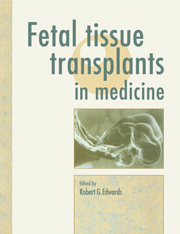Book contents
- Frontmatter
- Contents
- List of contributors
- Preface
- 1 Differentiation and transplantation of embryonic cells in mammals
- 2 Organogenesis and central nervous system development
- 3 Experimental human hematopoiesis in immunodeficient SCID mice engrafted with fetal blood-forming organs
- 4 Ontogeny of human T- and B-cell immunity
- 5 The procurement of human fetal tissues for clinical transplantation. Practice and problems
- 6 Transplantation of fetal haemopoietic and lymphopoietic cells in humans, with special reference to in utero transplantation
- 7 The biology of fetal brain tissue grafts: from mouse to man
- 8 Clinical results of transplanting fetal pancreas
- 9 The suitability of fetal and infantile donors for corneal transplantation
- 10 Transplantation of ovaries and testes
- 11 Cell grafting and gene therapy in metabolic diseases
- 12 The low temperature preservation of fetal cells
- 13 Law and ethics of transplanting fetal tissue
- Appendix: Code of practice on the use of fetuses and fetal material in research and treatment
- Brief bibliography on various aspects of transplanting fetal 337 tissue
- Index
3 - Experimental human hematopoiesis in immunodeficient SCID mice engrafted with fetal blood-forming organs
- Frontmatter
- Contents
- List of contributors
- Preface
- 1 Differentiation and transplantation of embryonic cells in mammals
- 2 Organogenesis and central nervous system development
- 3 Experimental human hematopoiesis in immunodeficient SCID mice engrafted with fetal blood-forming organs
- 4 Ontogeny of human T- and B-cell immunity
- 5 The procurement of human fetal tissues for clinical transplantation. Practice and problems
- 6 Transplantation of fetal haemopoietic and lymphopoietic cells in humans, with special reference to in utero transplantation
- 7 The biology of fetal brain tissue grafts: from mouse to man
- 8 Clinical results of transplanting fetal pancreas
- 9 The suitability of fetal and infantile donors for corneal transplantation
- 10 Transplantation of ovaries and testes
- 11 Cell grafting and gene therapy in metabolic diseases
- 12 The low temperature preservation of fetal cells
- 13 Law and ethics of transplanting fetal tissue
- Appendix: Code of practice on the use of fetuses and fetal material in research and treatment
- Brief bibliography on various aspects of transplanting fetal 337 tissue
- Index
Summary
THE MATURE HEMATOPOIETIC SYSTEM retains conspicuous embryonic features: extensive stem cell production, migration and differentiation ensure in the adult a permanent supply of myeloid and lymphoid elements. This enormous capacity for regeneration provides a unique opportunity for the investigator who can controllably reconstitute animals whose blood system has been ablated with cytotoxic drugs or ionizing radiation. Such experimental approaches in the mouse have been seminal in the study of stem cell biology, hematopoietic differentiation in blood-forming organs and 'self restriction of T lymphocyte function. Similar studies in man are, of course, deontologically unacceptable. Therefore, our understanding of human blood cell physiology still relies largely on animal paradigms or on the evaluation of in vitro cultured cells.
These approaches are of uncertain relevance and useful only in limited areas of investigation. Growing intact human organ pieces in a laboratory animal could obviously offer a key for the experimental study of living tissues in man. Transplantation is ideally achieved between histocompatible, syngeneic individuals, but xenogeneic chimeras can be constructed if the recipient is unable to mount a graftrejecting immune response. This condition can be met if the host is either an embryo, whose immune system has not developed yet (see LeDouarin (1978) for a review), or a congenitally immunodeficient adult. For example, human fetal tissues such as brain and pancreas have been implanted into athymic, partially immunodeficient rodents (Tuch et al, 1984; Stromberg et al., 1989). In a further step, lymphocyte-free mice, affected by the SCID (severe combined immunodeficiency) mutation, were used as recipients for human fetal bloodforming tissues (McCune et al, 1988) or isolated hematopoietic cells (Mosier et al, 1988).
Homozygous C.B.-17 scid/scid mutants, referred to hereafter as SCID, lack functional T and B lymphocytes as a consequence of defective rearrangements in antigen receptor genes (Bosma et al, 1983; Schuler et al, 1986). The prediction that human fetal tissue and SCID mice should be tolerant of each other was realized beyond expectations: fetal thymus was observed not only to survive in the mouse but to grow, differentiate and sustain hematopoietic activity. This discovery prompted attempts to approximate the cycle of human lymphopoiesis in the SCID mouse more closely by supplying the grafted thymus with hematopoietic precursor cells.
- Type
- Chapter
- Information
- Fetal Tissue Transplants in Medicine , pp. 77 - 96Publisher: Cambridge University PressPrint publication year: 1992



